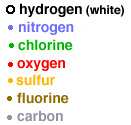Lewis Structures, Shapes, Polarity, Bond Lengths, Resonance & Formal Charge
Lewis Structures, Shapes, Polarity, Bond Lengths, Resonance & Formal Charge
Valence Shell Electron Pair Repulsion (VSEPR) theory allows fairly accurate prediction of the 3-dimensional shape of molecules from knowledge of their Lewis Dot structures. In VSEPR theory, the position of bound atoms (ligands) and electron pairs are described relative to a central atom. Once the ligands and lone pair electrons are positioned, the resulting geometrical shape presented by the atoms only (ignoring lone pairs) is used to describe the molecule.
Background Reading / Self Test: http://chemconnections.org/general/chem120/VSEPR/VSEPR-reading.pdf
Refer to: http://chemconnections.org/VSEPR-jmol/
Worksheet Printout .pdf
Complete the table with Lewis structures for the following compounds: 1A. CO2, 1B. SO3, 1C. H2O, 2A. NH3, 2B. CCl2F2, 2C. N2O, 3A. IF5, 3B. O3, 3C. BF3, 4A. SO2, 4B. SF6, 4C. PF3Cl2. Then view the molecule by clicking on the links below and accurately describe the shape of the molecule, [The images must be manipulated in order to get an accurate view of the molecules. ] Finally, indicate if the molecule is polar or non-polar. For example, 4A: SO2 , bent shape, polar molecule.

(The above color scheme is based on RASMOL colors . Under Jmol options select RASMOL colors for each image to best match the scheme.)
A B C 1
2
2B 2C 3
3B 3C 4 SO2
Bent. Polar4B 4C 2. View H2O, CCl2F2, CO2, BF3, and NH3. Using the respective Jmol images, determine bond lengths by double clicking on one atom and then single clicking an attached atom. Determine bond angles by then clicking on a third atom in the bonded sequence. Record the bond lengths and bond angles in each molecule. Enter them in the table. Draw each of the moleules in 3-d. Consider the electronegativities of the bonded atoms. Indicate which bonded atoms are relatively more electronegative and which are more electropositive using δ - and δ + to represent the respective partial charges. Use an arrow to represent the dipole vector for each bond. Indicate if the molecule is polar or non-polar. Rank the molecules: 1 to 5, from the lowest dipole moment, which equals 0 D, to the highest, which equals 1.85 D.
3. In the sulfur dioxide model, SO2, the bond lengths for each of the sulfur-oxygen bonds is the same, 0.145 nm, Briefly provide an explanation of this fact despite the Lewis structure shows an S-O single bond, which is >1.45 Angstroms, and an S=O double bond, which is < 1.45 Angstroms. Show resonance structures to illustrate your explanation.
4. In sulfur trioxide the bond lengths for each of the S-O bonds are the same, 0.157 nm. Briefly explain the difference between the longer bond length in sulfur trioxide versus sulfur dioxide, and also why sulfur trioxide is non-polar but sulfur dioxide is polar.
Last modified:rjr 1/15/12 at12:01 PM